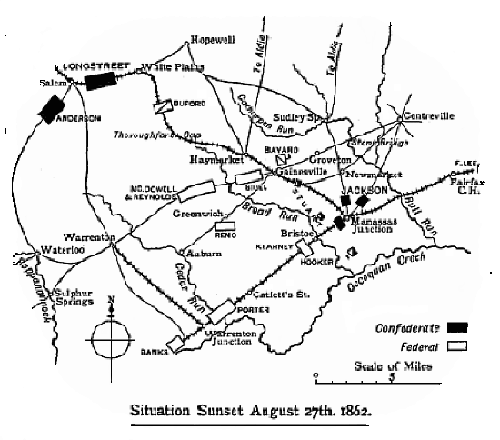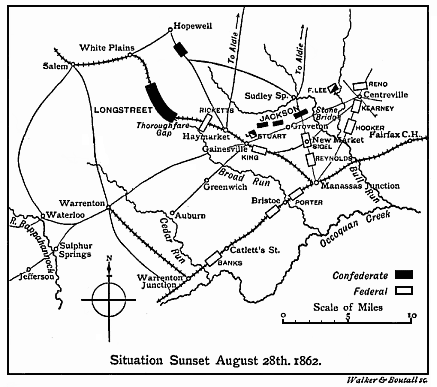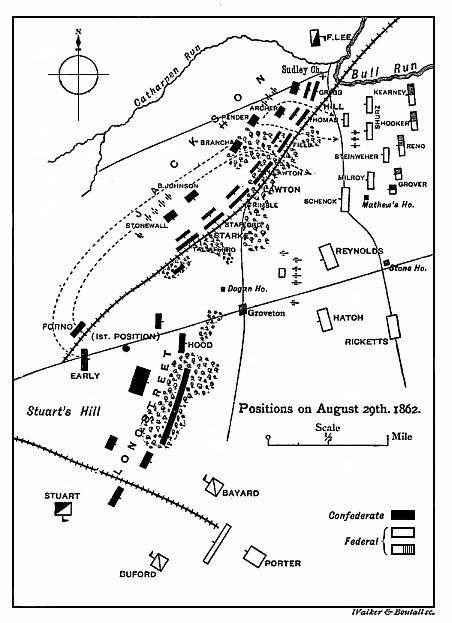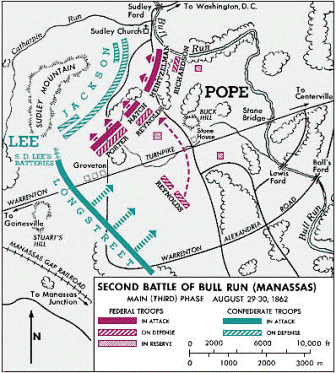Battle of 2nd Manassas/Bull Run
August 29-30, 1862
The Second Battle of Manassas marked the successful culmination of Lee's strategy to eliminate the Union threat to Richmond, and very nearly resulted in the destruction of Pope's Army of Virginia. On July 13,1862, with McClellan's Army of the Potomac showing no inclination to move from its base at Harrison's Landing, Lee sent Stonewall Jackson with his and Richard Ewell's divisions to confront Pope's Army of Virginia, then operating in central Virginia. When General of the Army Halleck responded by ordering McClellan to withdraw from the Peninsula and join Pope, Lee seized the opportunity to move the bulk of his Army from the defenses of Richmond to join Jackson and Ewell. Lee's plan was to engage Pope's Army of Virginia and hopefully destroy it before McClellan could complete his movement from the Peninsula. Success would open the way to an invasion of Maryland or Pennsylvania, perhaps prompting the Union to sue for peace.
Jackson met Pope at Cedar Mountain, eight miles south of Culpepper, on August 9. The Confederates prevailed, but suffered heavy losses, and Jackson withdrew south of the Rapidan on August 11. Four days later, Jackson met with Lee and Longstreet at Gordonsville to confer on the way ahead for the Army of Northern Virginia. Pope's army was deployed to the north of the Rapidan, and his offensive options were constrained by the necessity of maintaining a connection to Fredericksburg, from whence McClellan's Army of the Potomac was expected to come. With Pope's confidence shaken at Cedar Mountain, it took little to persuade him to withdraw behind the Rappahanock, and with encouragement from General Halleck and intelligence of a pending attack by Lee, he did so on August 18.
With his plan to attack Pope on the Rapidan frustrated by the Union withdrawal, Lee decided to circle around Pope's army to the west and threaten his rear by moving on Manassas. Jackson led this risky movement with instructions to avoid a decisive engagement until he could be joined by Longstreet, who froze Pope in place by confronting him across the Rappahanock. Pope's newfound caution prevented him from taking advantage of Lee's now divided army, which succeeded in reestablishing its cohesion on the morning of August 29 near Groveton, the same ground on which the first Battle of Manassas had been fought a year earlier.
On August 27, Pope moved to intercept Jackson, who was plundering the Union supply depot at Manassas Junction. The Excelsior Brigade and the rest of Hooker's Division, newly arrived from the Peninsula, met Ewell's division, serving as Jackson's rear guard, near Bristoe Station. After a hard fight Ewell broke off the engagement and withdrew to the north to link up with Jackson who was moving west toward Groveton from Manassas Junction. MGen John Pope reports on this engagement as follows: "On the afternoon of the 27th a severe engagement occurred between Hooker's division and Ewell's division, of Jackson's forces. The action commenced about 4 miles west of Bristoe Station. Ewell was driven back along the railroad, but still confronted Hooker at dark along the banks of Broad Run, immediately in front of Bristoe Station, at which point I arrived at sunset. The loss in this engagement was about 300 killed and wounded on each side. The enemy left his dead, many of his wounded, and much of his baggage on the field of battle....At dark on the 27th General Hooker reported to me that his ammunition was nearly exhausted, and that he had but about 5 rounds to the man left." [1]

Mindful of his orders to avoid a decisive engagement until rejoined by Longstreet, Jackson established defensive positions behind an unfinished railroad north of Groveton on the Warrenton Turnpike. There he awaited a hoped for attack by Pope while Longstreet completed his movement through Thoroughfare Gap to reunite the Army of Northern Virginia. Pope could have frustrated Lee's plan by taking up a defensive position in Centreville while McClellan's Army of the Potomac completed its withdrawal from the Peninsula, or he could have blocked Longstreet's advance at Thoroughfare Gap, but he was persuaded by scant evidence that Jackson was in retreat and vulnerable.
The first major engagement of 2nd Manassas began late in the afternoon of August 28 when a Union Division commanded by Rufus King, marching on the Warrenton Turnpike toward Centerville, was attacked by Jackson as they passed in front of his position. The fighting raged on into the late evening with heavy losses to both sides, and culminated with King's withdrawal toward Manassas.

The next day, August 29, still convinced that Jackson was withdrawing to the north or west and that he would be striking a relatively weak rear guard, Pope launched a series of uncoordinated attacks against Jackson's well entrenched forces. Longstreet arrived at about 10AM and fell in on Jackson's right, but Pope was not persuaded to abandon his belief in a Confederate withdrawal until the next afternoon.
The 71st New York Volunteers arrived on the battlefield from Centerville at about noon, and were later committed with the rest of the Excelsior Brigade to support an attack by James Nagle's 1st Brigade of the IX Corps' 2nd Division. This action was near the center of Jackson's line against Lawton's Division, and the Excelsior Brigade arrived just in time to be overwhelmed by the retreating remnants of Nagle's Pennsylvanians and the pursuing confederates. It was during this attack that Lewis Hawley was wounded and taken prisoner, only to be paroled four days later at Centerville.

The Battle of 2nd Manassas reached its climax late on August 30 when Lee advanced his right wing under Longstreet against Pope's left. Lee hoped to trap Pope between the two arms of his army as they closed like a giant hinge. Only a stout Union defense of Henry Hill and the approach of darkness saved the Army of Northern Virginia from annihilation. Finally recognizing the precarious situation of his army, Pope ordered a retreat to Centerville and his army withdrew during the night of August 30. The Union army had suffered a second discouraging defeat at Manassas.

A report of the 71st Regiment's role in this battle is provided by Captain Owen Murphy, who assumed command after Lt Col Potter was wounded. "The regiment, about 250 strong, under command of Lieut. Col. H. Potter, left camp near Warrenton Junction on Wednesday, the 27th and proceeded on its march in company with the other regiments of the brigade, which was commanded by Colonel Taylor, toward Catlett's Station. The day was hot and sultry, nevertheless the officers and men bore it well and patiently. In the afternoon we left the road and went through the woods until we came on an open field in front of a belt of woods to the left of the railroad near Bristoe Station, where we discovered the enemy. They opened fire on us, to which our men smartly and ably replied.
The conduct of the officers and men on this occasion was truly excellent. The number of officers present on this occasion was very small. They stood up to their fight like men, and after a sharp contest completely routed the enemy, whom we pursued for a considerable distance. Our loss was very severe in killed and wounded. Among the killed were Lieutenants Lowentrout, of Company D, and Murphy, of Company E. Among the wounded were Lieut. Col. H. L. Potter, whose conduct on the occasion was most excellent and praiseworthy; also Adjutant Powell, Lieutenants Franklin, Webb, and Captain Greene, who faithfully discharged their duties on the battle-field.
We slept on our arms that night about 3 miles in advance of the scene of action, having previously thrown out a strong picket guard, until morning. We left with the brigade about noon on Thursday, the 28th,and went toward Manassas without interruption, seeing nothing on the way but traces of destruction and desolation by the enemy. We encamped for the night near Bull Run, and proceeded on our march next morning (Friday, 29th) about 3 o'clock in the direction of Centreville, where we halted to rest for some time, and proceeded in the heat of the day toward the scene of battle, where we arrived about noon. Here we remained for a short time awaiting orders, when we were called to the front in company with the brigade to relieve others who had been there engaged with the enemy.
It gives me great pleasure to be able to state that the regiment behaved exceedingly well. The conduct of the officers and men on this occasion as on the former one was creditable alike to themselves and their superior officers. The coolness, firmness, and courage displayed at this trying time is worthy of all admiration. Not an officer (seven only being present) or private flinched from his post when flanked by the enemy until ordered to fall back by Acting Brigadier-General Taylor, whose presence, coolness, and good judgment inspired the officers and men with the highest confidence in his ability as a commanding officer. We fell back, after considerable loss in killed, wounded, and missing, to our former position. Our loss on this occasion, although severe, was not as heavy as on the 27th. We slept on our arms for the night, and remained there till the next afternoon (Saturday, 30th), when we were ordered up to support a battery in front, where we were much exposed to the artillery fire of the enemy. At night we fell back in good order to the bridge destroyed by the enemy within half a mile of the battlefield and marched in the direction of Centreville, where we remained for the night, and camped there for some days afterward."[2]
A more complete description of the Excelsior Brigade's participation in these battles is provided by Captain C. L. Young of the 1st Excelsior. "In compliance with orders from brigade headquarters I have the honor to report the part taken by this regiment in the recent battles at Bristoe Station, on the 27th, and Bull Run, on Friday and Saturday, August 29 and 30: The regiment received marching orders at Warrenton Junction on the morning of the 27th, and before breakfast was on its way toward Bristoe, being fourth in line of march. The first indication of the presence of the enemy was made known by an exchange of shots between our skirmishers and the rebel pickets. Over a road, through a dense wood, running parallel with the Manassas Railway, the Third Brigade was hurried forward and placed in line of battle facing the enemy's left center, quickly supported by the Second, Fourth, and Fifth Regiments of the Excelsior Brigade. Musketry from the front, artillery from the left, played furiously upon us, soon followed by a murderous fire on our right flank from behind the railway embankment. Under this terrible triple fire the First and Third Regiments were ordered forward by Colonel Taylor, commanding the brigade, to protect our flank, which they did under cover of a friendly slope over-looking the enemy's formidable position.
At this time the fight raged fearfully, each contestant holding well his ground. Our comrades fell thick and fast. All felt sad when the gallant Lieutenant Hoxie fell with a Minie through the groin. It was then that Lieutenant Kay proposed a charge. A cheer was substituted, to give time for consultation with Captain Bliss, commanding Third Excelsior, relative to the expediency of following Lieutenant Kay's suggestion. Hardly had that glorious cheer mingled with the whistling bullets ere the rebels began to fall back before the eyes of our eager men. Folly it would have been to hold our force then, for the railroad must be gained. The men were already up, and as a unit pressed forward, planting our colors on the track and securing the rebel dead and wounded. Some wished to pursue the enemy, but fearing to disarrange plans, we thought best to remain in our present position, which accorded with Colonel Taylor's ideas when he came from the center.
Meanwhile General Hooker had placed a battery in position on the left, which under his personal supervision quickly silenced the guns of the enemy. His right and left broken, we found no difficulty in piercing his center and gaining possession of the field. We bivouacked for the night 1 mile in advance of the battle ground, throwing forward a strong picket. Early on the 28th we resumed march for Manassas Junction; passed on, stacking arms toward night at Union Mills.
Left Union Mills August 29, at 3 a.m., reaching Centreville before 9 a.m., when we ascertained the enemy had made a stand beyond Bull Run. Our division was early ordered forward, reaching the field about noon. The First and Third Brigades were engaged first, the Excelsior (Second) being held in reserve. Twice our position was changed, soon bringing us within supporting distance. The battle raged fearfully, the enemy making a desperate stand, never flinching. His artillery worked splendidly, exerting us to hold him in check. It soon became necessary to forward our brigade. Forming in line of battle facing a long wood, the Third Regiment on the extreme right, this command directly on their left and on the right of the other regiments of the brigade, with three regiments numbering 2,400 strong immediately on the left of our brigade, we moved cautiously and steadily into the wood to relieve a force already engaging the enemy, who was behind and holding a railway. We had fairly time to reach the point designated when the rebels, with a murderous shout, accompanied by a sharp fire, broke through the brigade in front, forcing them pell-mell on our line of battle, at the same time skillfully turning our left flank and routing the brigade on our left from the wood, our men never wavering until Colonel Taylor saw it would be madness to expose his command to the mercies of a desperate and much larger foe. As it was, we held our ground until many of our mounted officers were dragged from their horses and our colors within the enemy's grasp. Still undaunted, Colonel Taylor rallied his little force at the edge of the wood that he might send skirmishers back to protect the recovery of our wounded comrades, never leaving the field until the skirmishers had been twice driven in and orders arrived from General Hooker for us to retire.
We passed the night on the top of a hill in the rear of a reserve battery. This regiment and the others of the brigade were employed on Saturday, the 30th ultimo, in supporting batteries under the most deadly artillery fire we had ever been placed, but with little loss of life and limb, owing to the skillful manner in which we were placed and handled by the brigade commander. Toward night the enemy turned the entire left of General Pope's line, when our brigade, with the batteries we had been supporting, were ordered back to Centreville, where we went into camp about midnight, resting the 31st until eve, when we were marched in the direction of Fairfax. Meanwhile Generals Kearny and Stevens had been attacked near Chantilly. Colonel Taylor was ordered to their support; remained under arms in line of battle all night in a drenching rain, but was no engaged. Just before dawn we resumed march, reaching Fairfax Court House for breakfast, when Major Holt reported for duty and assumed command of the regiment."[3]
The Excelsior Brigade suffered 47 killed, 217 wounded and 64 missing during these engagements, with the 71st suffering most heavily. Hooker's 2nd Division numbered fully 10,000 men at Yorktown, and received a reinforcement of about 3,000 more; after Manassas, it drew rations at Fairfax Station for only 2,400 men. The 71st and the rest of 3rd Corps was ordered into the defenses of Washington, near Alexandria, to rest and recruit. They remained there during the battle at Antietam and rejoined the army in early November, just in time for Burnside's disastrous attack on Fredericksburg.
[1] O.R.--SERIES I--VOLUME XII/2 [S# 16], No. 2.--Reports of Maj. Gen. John Pope
[2] O.R.-- SERIES I--VOLUME XII/2 [S# 16], No. 17.--Report of Captain Owen Murphy
[3] O.R.-- SERIES I--VOLUME XII/2 [S# 16], No. 76.--Report of Captain Charles L. Young